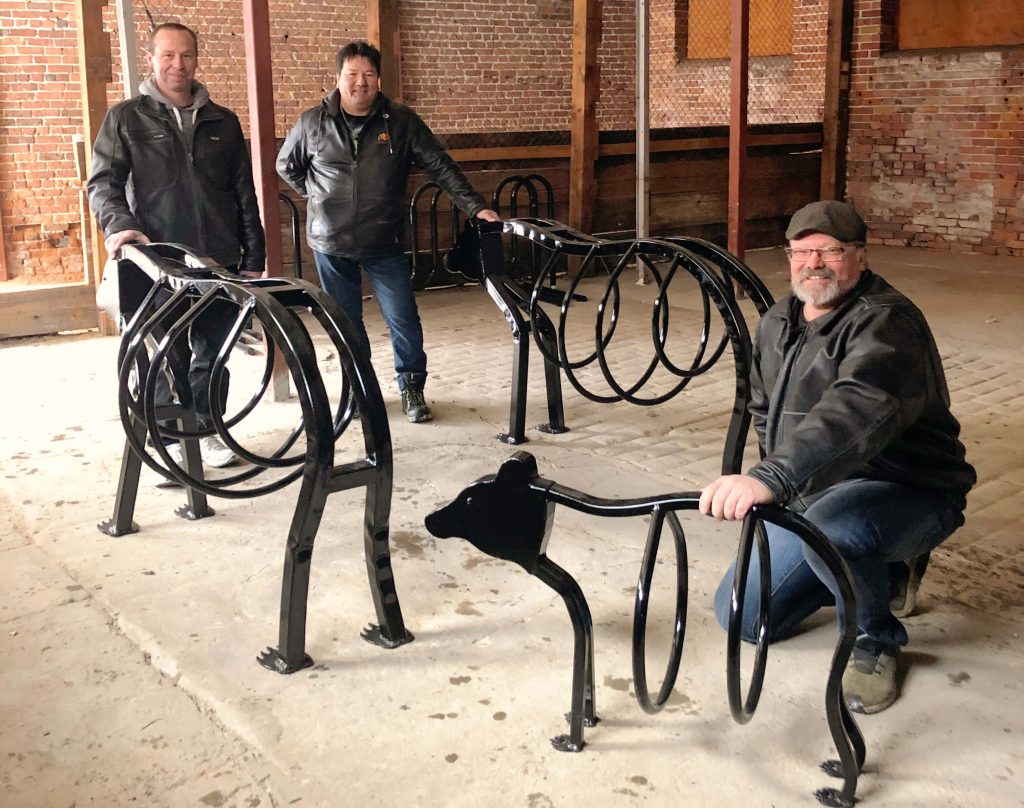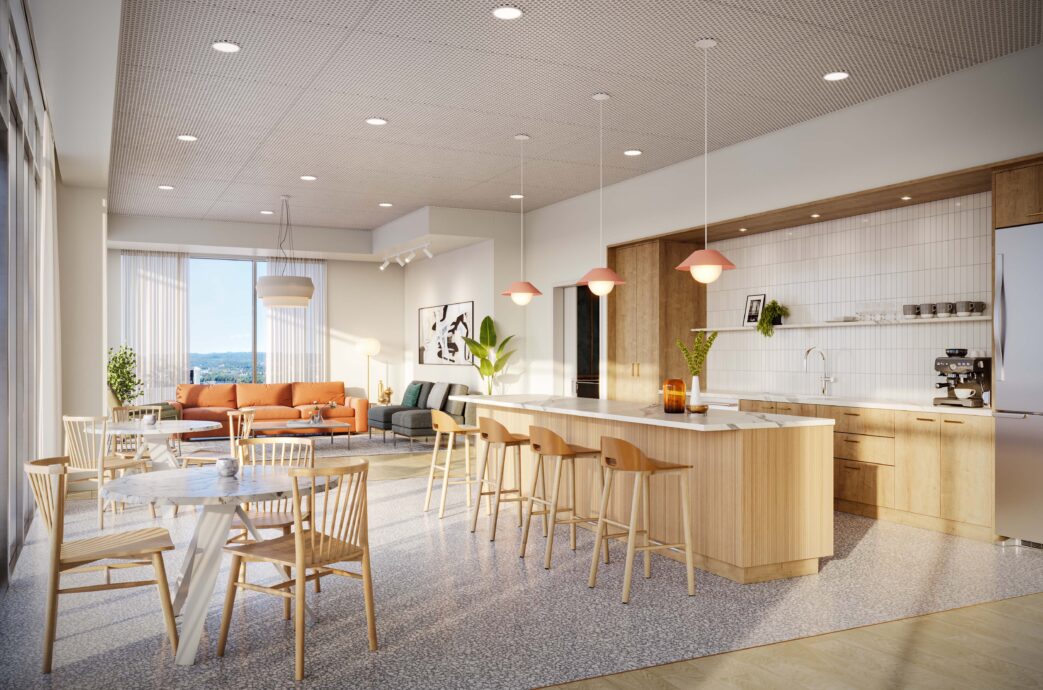Photo of Josee Bourgeois in traditional regalia at Chaudiere Falls, in Ottawa/Gatineau. Photo by Paul Couvrette, couvrette-photography.on.ca
Take a moment to think about an urban space that makes you feel like you belong. Maybe it’s a place where you see your history reflected in street or building names, statues, and even in plants and trees.
The feeling of belonging, and seeing oneself reflected in your built environment, is unfortunately something rarely experienced by Indigenous Peoples in this part of Canada, on the traditional and unceded territory of the Algonquin Anishinabe (“Ah-nish-nah-bay”).
While the National Capital Region is dotted with the names and statues of historical characters that history books tout as Canada’s builders, there are many gaps in representing the original owners and stewards of the lands prior to European contact and subsequent colonization. Sure, we now have the Pimisi LRT Station, but this is one of the very few instances of Algonquin representation of any kind in the region. Until now…
There is a real opportunity to build urban spaces in a way that reminds non-Indigenous people of where they live. And that is what Zibi is aiming to do in partnership with a very dedicated group of Algonquin women leaders – the Memengweshii Council (“meh-men-gweh-she”) who advise the Zibi project in matters of Algonquin culture, language, and protocols.
One of the members of the Memengweshii Council is Josee Bourgeois, an Algonquin Anishinabe who grew up in Ottawa and Toronto, where proud First Nation representation was completely absent for her.
“Across Toronto you’ll find a China Town, Greek Town, Little Portugal, Korea Town, and others, but nowhere will you find a place that represents the Anishinabe whose traditional territory the city was built on.” says Bourgeois.
“Most difficult for me, as a young First Nation woman, the only true representation of my culture in the urban public realm were homeless people on the streets. How cruel and ironic that the Peoples who are truly “from here” have no community of their own. The original caretakers of the land are the only peoples without so much as a street or statue to represent them, that they are represented by homelessness.”
Despite this difficult truth, Josee has taken her place as a strong voice and advocate for better First Nation representation in places like Ottawa, Gatineau and Toronto. She is a trailblazer and leader showcasing Algonquin Anishinabe culture wherever and whenever possible. Whether she is demonstrating traditional dance at the National Arts Centre, teaching pow-wow step groove to young people in schools and online, speaking in schools across Ottawa-Gatineau about the histories of injustice for First Nation Peoples, or participating in high profile political events hosting British Royals on her ancestral territory.
As a member of the Memengweshii Council, Josee has taken up the mantle for proper representation in the built environment. Over the last 7 years, during dozens of community consultations, sharing circles, dialogues with Knowledge Keepers, meetings with Chiefs and Councils, site visits and more, Josee and the Council, with support from Zibi project staff and consultants, began to try to understand what an Algonquin Anishinabe urban waterfront community could and should look like.
Some of the things Memengweshii, and Zibi, learned will be reflected in the waterfront city in the following ways.
Intuitive wayfinding
Before maps and street signs, Indigenous communities used innovative practices to navigate, mark and memorize their lands. The waterways and flow of the Ottawa rivershed, animal prints and tracking, directional trees and tree markings are examples of ways nature was used to guide travel and movement. Reincorporating some of these practices of wayfinding and navigation in an urban setting honours those traditional ways.
- Zibi wayfinding will be guided by trilingual signage (Algonquin, French and English) and symbols, as well as the movement of the sun, directing visitors from sunrise to sunset. Zibi is working with the local artist community to develop guiding imagery in the ground plane representing the stages of the sun , which will direct pedestrians towards waterfront park spaces, co-designed by Algonquin partners.
Use of local, natural, sustainable materials
For generations, Algonquins used the land and local resources to live, while caring for it to ensure the survival of future generations. The Algonquins were known as people who “walked lightly on the land,” and thus the impact of their existence for millennia in Ontario and Quebec is hardly seen or evident. This way of life is what preserved the lands for the benefit of those enjoying it since.
- All landscaping, planting and greenery onsite are Indigenous plant species native to the area, and reviewed by Algonquin knowledge keepers in communities. Many of the colour palettes chosen for buildings and plaza hardscapes are neutral and natural tones, like nature itself. Plaza stones are also being organized in patterns of importance to the Algonquin, resembling the weaving patterns of traditional ash or quill baskets, or the braiding of traditional medicines. These design inspirations are also being integrated in other public realm items, such as railings, shelter structures, benches, bike racks, and more.
Full use of materials/No waste
The full use of every part of an animal, every part of a tree or plant was traditionally important for the Algonquin: a waste-free mentality now made popular again with the zero-waste sustainable movement. What’s old is new again…
- As a One Planet community, Zibi has made a commitment towards achieving a target of 95% waste diversion from landfills. In fact, in 2019, it achieved a 99% rate in construction and by residents living on site. Further, Zibi is committed to repurposing materials from the historic buildings. Last year, a total of 90% of demolition material was sorted and hauled to a local recycling facility for the purpose of reuse.
Culture – before, now and later
There is a tendency to illustrate First Nation cultures as static, what we have seen in history books and museums. The Algonquin Anishinabe are quick to point out that, just as any other culture, theirs is alive and evolving. It looked a certain way prior to European contact and post-colonialism; it is taking on new forms today; and, it will look different and continue to evolve tomorrow. It is imperative to reflect Algonquin culture not in its static past form, but in its evolving state, in constant evolution and redefinition.

A “family” of bear bike racks by Algonquin artist Karl Chevrier will be installed at Zibi this summer.
- Public art at Zibi will tell important stories about the Peoples of our region before, now and in the future. Through an innovative partnership with the Artscape organization, large scale art and installations will be another way in which Algonquin Anishinabe will see their stories and culture reflected in an urban space, and finding ways to teach and relearn language and culture. One recent example, Zibi has commissioned the creation of custom bike racks in the shape of black bears (“Makwa”, an animal of traditional siginificance) from local Algonquin artist Karl Chevrier of Timiskaming First Nation.
Trade, exchange and collaboration
The use of local, natural and sustainable materials was true for various Nations living across Turtle Island (now known as North America), making their way across the continent through trade routes amongst and between Nations. Precious metals like copper was of significant importance to the Algonquin, though there was none present in the traditional territory. This demonstrates the collaborative nature of Algonquin peoples with other Nations, the creative entrepreneurship that existed well before European ways of thinking and doing. The interconnectedness of First Nations peoples is something worth representing at Zibi.
- Zibi has developed a meaningful and sincere relationship with the Memengweshii Council, and through them, with the Elders and Knowledge Keepers in the local communities. This relationship has made it possible for Zibi to learn about certain elements, symbols, colours or items that are of great importance or sacred to Algonquin Anishinabe. As a result, Zibi will include some of these elements, symbols, colours or items found on site that may be meaningless or unremarkable to non-Indigenous visitors, but would be significant to the trained Algonquin Anishinabe eye who could immediately notice these, and know it was put there for them. Culture in this instance is woven and embedded in the physical space, ready to be discovered and explored.
To have “walked lightly on the land” means that you lived in a sustainable way, in harmony with nature; however, that also meant that you left no trace. From an urban design perspective, it has been a challenge to demonstrate a culture that has been so gentle with its landscape, unlike the conventional western dominant cultural practices of grandiose monuments and testaments of power. Zibi’s designation as Canada’s only One Planet community, and the commitments it has made towards sustainability, are a way for us to also walk lightly on the land.
Zibi’s Indigenous placemaking efforts have a simple goal: to be a physical and undeniable reminder to all visitors and residents to the region that we live, play and work on unceded Algonquin territory in this part of the world.
On National Indigenous Peoples Day today, and every day, it is our shared responsibility to ensure that the culture of those on whose territory we live are represented, and present in our daily rituals and thoughts.









